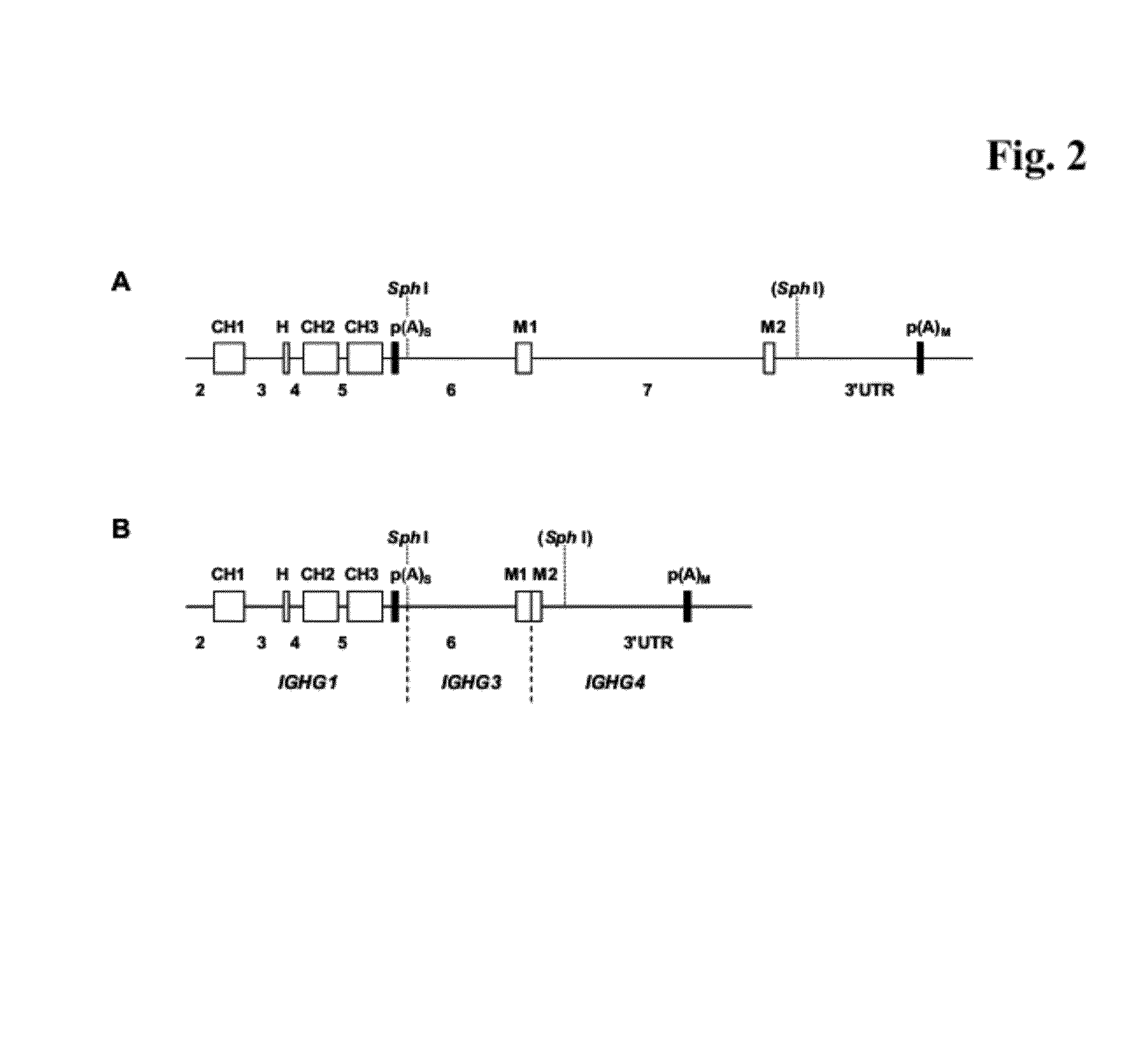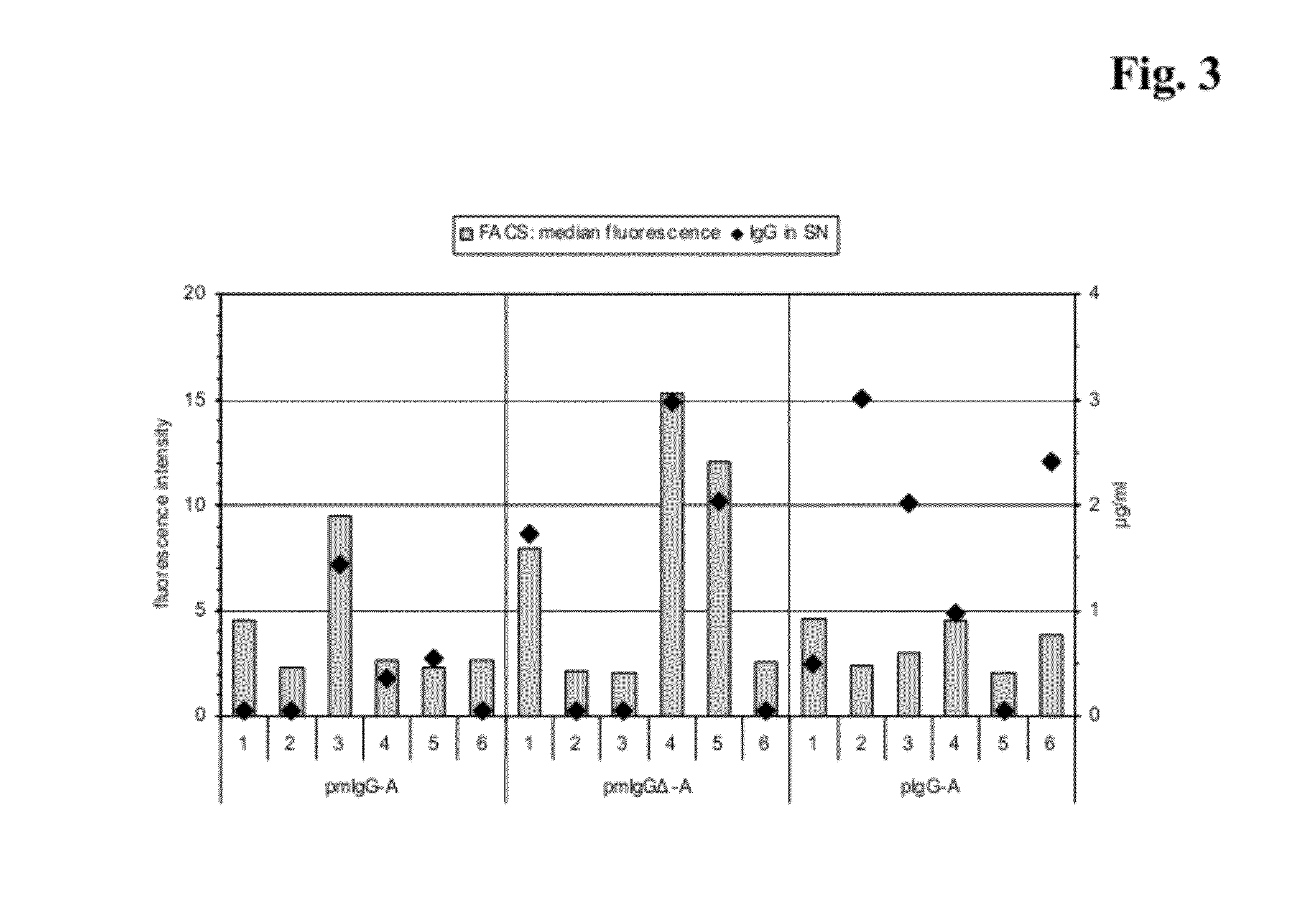Polypeptide producing cells
a technology of polypeptides and producing cells, which is applied in the field of polypeptide producing cells, can solve the problems of time-consuming and consequently expensive problems
- Summary
- Abstract
- Description
- Claims
- Application Information
AI Technical Summary
Benefits of technology
Problems solved by technology
Method used
Image
Examples
example 1
[0409]Cloning of Genomic Fragments and Construction of Eukaryotic sIgG / mIgG Expression Vectors
a) Construction of the sIgG Expression Vector ‘pIgG-A’
[0410]For the expression of an immunoglobulin with specificity against a protein “A” the vector ‘pIgG-A’ was constructed. It codes for the secreted sIgG form of the immunoglobulin and comprises the following elements (see FIG. 1C):[0411]1. A transcription unit for a human gamma (γ) 1 heavy chain, composed of[0412]the immediate early enhancer and promoter from the human cytomegalovirus (hCMV),[0413]a synthetic 5′ untranslated region including a Kozak consensus sequence (Kozak, M., Nucleic Acids Res. 15 (1987) 8125-48),[0414]a murine immunoglobulin heavy chain signal sequence including the signal sequence intron,[0415]a variable heavy chain cDNA of an antibody with specificity against a protein “A”,[0416]a mouse / human heavy chain hybrid intron 2 including the mouse Ig μ enhancer (JH3-JH4 switch region) joined with the human immunoglobulin ...
example 2
[0469]Transfection and Analysis of Sp2 / 0-Ag14 Cells
a) Cultivation and Electroporation of Sp2 / 0-Ag14 Cells
[0470]Sp2 / 0-Ag14 hybridoma cells (ATCC No. CRL-1581, Shulman, M., et al., Nature 276 (1978) 269-270) are cultivated in RPMI medium (Invitrogen Corp., US) supplemented with 10% ultra-low IgG fetal calf serum (FCS) (Invitrogen Corp., US) and 2 mM glutamine (Invitrogen Corp., US) at 37° C., 5% CO2 and 95% humidity. For transfection the cells are electroporated with 10 μg plasmid DNA per 106 cells in 20 mM HEPES-buffer (N-(2-hydroxyethyl)-piperazine-N′-2-ethanesulfonic acid), pH 7.0 containing 137 mM NaCl, 5 mM KCl, 0.7 mM Na2HPO4, and 6 mM Glucose at 4° C. The electroporation is performed at 220 V and 960 μF with a Genepulser electroporation device (Bio-Rad Laboratories Inc., US). After the transfection the cells are distributed to 96 well plates with 5000 cells in 100 μl medium per well. For the selection of transfected cells 500 μg / ml G418 (Roche Diagnostics GmbH, Germany) is adde...
example 3
[0474]Sorting of Stably Transfected Cells by Flow Cytometry
[0475]For the generation of clones stably expressing IgG 3×106 Sp2 / 0-Ag14 cells were transfected with the plasmid pmIgGΔ-B by electroporation as described above. One day after the transfection the cells were transferred to 500 μg / ml G418 selection medium and cultivated as pool for about two weeks. After the selection the IgG bound to the surface of the transfected cells was labeled and cells with the most intense signals were sorted by flow cytometry. Therefore 4×106 cells from the pool were washed two times with medium at 4° C. then incubated with fluorescein (FITC)-conjugated F(ab′)2 fragment mouse anti-human IgG (Dianova, Germany), 1:50 diluted in medium, for 20 minutes on ice. After two washing steps with medium the cells were resuspended in medium and transferred to a BD FACSVantage flow cytometer (BD Biosciences, US). A gate was set encompassing cells with the top 5-6% of fluorescence intensity of the sample population...
PUM
| Property | Measurement | Unit |
|---|---|---|
| humidity | aaaaa | aaaaa |
| humidity | aaaaa | aaaaa |
| humidity | aaaaa | aaaaa |
Abstract
Description
Claims
Application Information
 Login to View More
Login to View More - R&D
- Intellectual Property
- Life Sciences
- Materials
- Tech Scout
- Unparalleled Data Quality
- Higher Quality Content
- 60% Fewer Hallucinations
Browse by: Latest US Patents, China's latest patents, Technical Efficacy Thesaurus, Application Domain, Technology Topic, Popular Technical Reports.
© 2025 PatSnap. All rights reserved.Legal|Privacy policy|Modern Slavery Act Transparency Statement|Sitemap|About US| Contact US: help@patsnap.com



